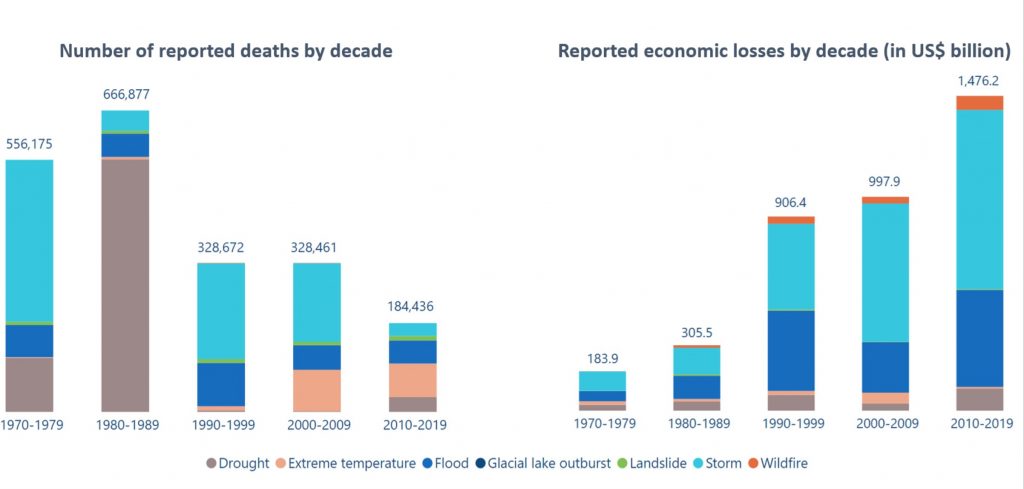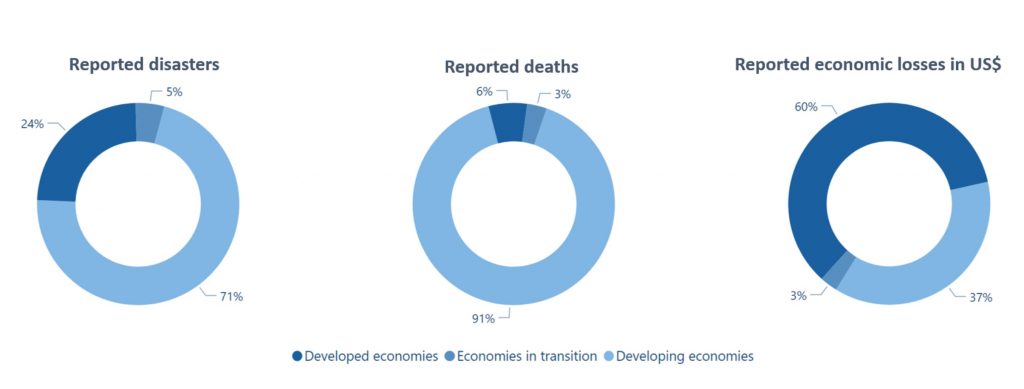https://www.valigiablu.it/crisi-climatica-eventi-estremi-come-salvare-vite-umane/
- |
The weekly round-up on the climate crisis and data on carbon dioxide levels in the atmosphere.
The greater intensity and frequency of extreme meteorological phenomena are now causing enormous damage at all latitudes and unfortunately the death of many people caught unprepared by events for which we were not prepared.We have also seen it in Italy, recently in Emilia-Romagna twice within a few weeks, and last September in the Marche.But early warning systems and better management of the devastating effects of these catastrophic events can save many human lives.At least according to what one reports study by the World Meteorological Organization (WMO).
Floods in Emilia-Romagna:an announced disaster and because climate change is also involved
According to the report, in the countries most exposed to the consequences of the climate crisis, floods, storms and fires have caused trillions of dollars in economic damage over the last half century, but the number of human victims has fallen dramatically over the years.

Since 1970, the WMO reports, two million people have died due to extreme weather events.But between 2019 and 2021 there were 22,608 victims, a lower number than in previous years.The cost of damage caused by these events has increased eightfold and now exceeds $4 trillion.
The greatest economic damage was recorded in the richest countries.Extreme weather events have cost these countries approximately $1.7 trillion, 39% of the global total over the past 51 years.However, least developed countries and small island states have experienced much higher costs relative to the size of their economies, the WMO adds.

Asia accounted for 47% of all reported fatalities globally - nearly one million - with tropical cyclones as the leading cause.Bangladesh has recorded the highest number of deaths in Asia since 1970 (520,758 people, attributed to 281 disasters).In Europe, 166,492 people died in 1,784 disasters, accounting for 8% of the total worldwide.
The decrease in the number of deaths - continues the report - has nothing to do with the lower frequency or severity of these events, which have increased fivefold.This result is, therefore, the result of improvements in protection measures for the populations who live in the territories most vulnerable to these disasters.
“The most vulnerable communities unfortunately bear the brunt of risks related to weather, climate and water,” he declared the Secretary General of the WMO, Petteri Taalas.
Cyclone Mocha, the tropical storm that hit parts of Myanmar and Bangladesh last week, has caused widespread destruction, affecting some of the poorest communities.“At least 800,000 people are said to be in need of emergency food aid and other assistance, but the number of deaths is currently estimated to be less than 200.In the past, a storm like this would have caused tens or even hundreds of thousands of deaths,” explains Taalas.“Thanks to early warning and disaster management, these catastrophic mortality rates are now fortunately history.”
By 2027, the WMO warns, all inhabitants of the planet should be able to receive high-quality timely warnings in case of imminent disasters.
Nigeria:According to a report, Shell and ENI are expected to pay $12 billion to clean up oil spills, but the two companies deny responsibility
Nigeria it is the largest oil producer of Africa and churns out almost 1 million barrels of crude oil per day.But the consequences of the spills for local communities are devastating.
The community of Oruma, in Nigeria's oil-rich Niger Delta region, sHe's still suffering for the 2005 oil spill from a Shell pipeline on farmland.The oil spill caused widespread damage to local ecosystems, turning the lush forest - once the main source of income for farmers and fishermen - into a contaminated landscape.In 2021 a Dutch court he thought Shell responsible for the disaster and ordered it to compensate the community of Oruma for the damage suffered.
Lately, according to a report by the Bayelsa State Petroleum and Environmental Commission, the total volume of oil spilled in Bayelsa was at least 10 times larger than the 1989 Exxon Valdez oil tanker catastrophe, which damaged approximately 1,000 kilometers of coastline in Alaska, United States.
Bayelsa was the first area in West Africa to produce commercial quantities of oil in the late 1950s.Since then, companies - mainly Shell and ENI - have pumped billions of barrels of crude from the state's land, swamps and waterways.Oil spills from their infrastructure have turned the region into "one of the most polluted places on Earth," the report said.
The Commission says Shell and ENI must pay at least $12 billion for the cleanup.However, the two oil companies have maintained that they are not responsible, blaming the oil spills on saboteurs and crude theft.But, according to the report, companies have failed to "adequately invest in, maintain, operate and protect pipelines" which develop spills at a rate "unmatched by other major oil producing countries" and there are also "strong reasons to believe that official statistics overestimate significantly and systematically the number of spills caused by sabotage, minimizing those attributable to other causes".
The impact of oil pollution is not limited to the environment.Studies conducted for the Commission found that “toxins from oil pollution are present at often dangerous levels in soil, water and air” throughout Bayelsa and “have been absorbed into the human food chain.”The report reports that toxic pollutants were also detected in the blood of the inhabitants. Communities and activists have long accused oil companies of failing to ensure the safety and maintenance of pipelines.
The Commission he identified a series of interventions that could remedy the damage done to Bayelsa e recommended a review of the rules to allow for heavier fines and limit the influence of manufacturers from “fundamentally compromised” spill control and verification activities.As it stands, the report says, government departments responsible for enforcing environmental standards lack "capacity, independence and influence".
The European Parliament has postponed the vote on renewable energy after opposition from some European countries
The European Parliament has postponed the approval of new EU renewable energy targets, after opposition from France and other countries close to the vote.The vote, which seemed like a formality, was postponed until June.
The law, reports Reuters, sets the binding objective for the EU to obtain 42.5% of energy from renewable sources by 2030.The negotiators of the European Parliament and the member states seemed to have now agreed in detail on the final agreement, but at the last moment France asked for greater recognition of nuclear energy.Furthermore, writes Always Reuters in another article, eight countries, including Italy, "are pushing to weaken the EU's new emissions limits for cars, arguing they are too ambitious and unrealistic for automakers."
The European Union is also trying to pass two important nature laws before next year's European elections:binding targets for member countries to restore damaged natural habitats and halve the use of chemical pesticides by 2030.Unfinished laws are piling up.Their fate would be unclear if the new EU Parliament had a different composition.Many EU environmental laws have been passed in the last two years, but as the months go by is increasing the resistance of some states and interest groups. This month the French President, Emmanuel Macron, suggested a pause on new European environmental regulations, to give industries time to absorb the recently agreed laws.
In Asia, water and energy are at risk due to climate change
The Hindu Kush-Himalaya water system is put to the test from the impacts of climate change, reports research from the China Water Risk think tank.Melting glaciers and extreme weather conditions are putting the economic progress and energy stability of 16 Asian countries at risk, the study says.
The authors of the research say that ten rivers, including the Yangtze and Yellow Rivers in China, could experience "exacerbation of water risks without emissions reductions".Precisely the Chinese Yangtze river basin, which supports about a third of the country's population and about 15% of its energy capacity, he experimented last year a record drought, with a collapse in hydroelectric production which he provoked the disruption of global supply chains.After the drought, governments they approved dozens of new coal plants to avoid future hydropower outages.However, coal power also needs water, and increased capacity in China and India could further exacerbate the shortage.
The Sin Chew Daily, a Chinese-language newspaper from Malaysia, reports that “unusual snowfall” occurred in several regions of northern China in May, including Shaanxi, Ningxia and Xinjiang.According to experts, more extreme weather conditions are expected in China this year due to global warming, the newspaper noted.The Ministry of Ecology and Environment he announced a worsening of air quality in the country, with the number of days of "severe and above average air pollution" more than doubling, rising to 3.6% from 1.6% the previous year. Caixin reports an analysis that, in the presence of "extreme temperatures", companies located in Beijing, Shanghai, Shenzhen and some inland provinces, such as Sichuan and Hebei, "could be exposed to potentially higher losses" .
Second an analysis of the British site Carbon Brief, China's carbon dioxide (CO2) emissions grew 4% in the first quarter of 2023, reaching a record high for the first three months of the year.Based on year-round projections, China's emissions will likely reach an all-time high in 2023, surpassing the previous peak in 2021.The rapid expansion of low-carbon energy, if sustained, could allow emissions to peak and enter structural decline once the post-Covid recovery fades, he concludes Carbon Brief.
In an interview with China Electricity and Energy, a journal supervised by the NEA, Lin Weibin, head of the energy policy research bureau of the China Energy Research Society, said that China plans to build a “new energy system capable of bringing a high level of electrification and to achieve a high level of decarbonisation".Lately, according to what he reports the state media China National Radio, Chinese President Xi Jinping declared that China has embarked on a “unique path of biodiversity conservation with Chinese characteristics” and spoke of a “Chinese solution” and a “Chinese experience” for building a global community of the future shared and for the promotion of sustainable human development.
Climate change has already pushed 9% of humanity out of the “climate niche” suitable for human life
According to a new study published on Nature, climate change has already pushed 9% of humanity - more than 60 million people - out of the "climate niche" in which the human species has lived for the last 300 thousand years or so.
According to the authors of the research, areas with average annual temperatures above 29°C are outside the human climatic niche.With current policies, which are leading to an increase in temperatures of 2.7°C compared to pre-industrial temperatures, approximately 2 billion people, equal to 22% of the population expected by the end of the century, are at risk of similar exposure.
In the "worst case scenarios" of global warming of 3.6 °C, or 4.4 °C, half of the world's population could remain outside the climatic niche in which the human species evolved according to what the authors of the research have defined as an “existential risk“.
“The costs of global warming are often expressed in financial terms, but our study highlights the phenomenal human cost of failing to address the climate emergency,” he said Tim Lenton, director of the Global Systems Institute at the University of Exeter and lead author of the study.
For every 0.1°C of additional warming above current levels, approximately 140 million more people will be exposed to dangerous heat.
However, by reducing warming from 2.7°C to 1.5°C, the number of people exposed to unprecedented heat would decrease fivefold.“The emissions of approximately 3.5 average global citizens today (or approximately 1.2 average US citizens) expose a future person to unprecedented heat by the end of the century,” the study concludes.
How a small news site built an innovative data project to visualize the impact of climate change on Uruguay's capital
La “ciudad sumergida” (The submerged city), an investigation carried out by the Uruguayan science and technology news site Amenaza Roboto, he used maps of the capital of Uruguay, Montevideo, to visualize, through very evocative images, the impact that rising sea levels are expected to have on the city and its infrastructure.The investigation he noted that the country's critical infrastructure, vulnerable neighborhoods and wealthiest neighborhoods risk being inundated if the effects of climate change are not prevented.
One of the objectives of the survey was to calculate the population exposed to the risk of flooding due to sea level rise in Montevideo.Data downloaded from the National Environmental Observatory (Ministry of the Environment of Uruguay), the National Institute of Statistics (INE), the Ministry of Social Development, the Municipality of Montevideo, among others, were used.The inundation surfaces were extracted from the report of the National Plan for Adaptation to Climate Change and Variability of Coastal Zones in Uruguay.The Amenaza Roboto team developed a data analysis methodology that made it possible to discover information relevant to citizens hidden in public documents of the Uruguayan state.
Although Uruguay already has open government data, it is difficult for citizens to access relevant and up-to-date databases.Furthermore, if data exists and is accessible (as is the case in our survey), the technical capabilities needed to process it are usually not available.If we add to these difficulties the approach to complex issues such as climate change, the mission becomes even more difficult.For this reason, the project – first of its kind for Uruguay – it is a good example of how news sites could investigate and communicate the effects of climate change on local communities.
Nearly 400 new species discovered in the Greater Mekong but they are already at risk of extinction
Two hundred and ninety plants, 20 fish, 24 amphibians, 46 reptiles and one mammal they were discovered recently along the Mekong River in Asia.
Almost 400 new species discovered in Greater Mekong region – in pictures#biodiversity https://t.co/U1qC8uOSrc
— Damian Carrington (@dpcarrington) May 23, 2023
«These extraordinary species are not the last and although they are new to science they have actually been evolving in the Mekong region for millions of years.They remind us that they were there long before we arrived in this region." he said K.Yoganand, leader of the WWF-Greater Mekong regional wildlife conservation project.As of 2021, there are over 3,389 species known in the region.“The Mekong region is recognized as one of the main biodiversity hotspots in Asia,” added Truong Q.Nguyen, deputy director at the Institute of Ecology and Biological Resources of the Vietnam Academy of Science and Technology – And it is for this reason that naturalists choose it to reveal its secrets."
Many of the recently discovered species are already threatened with extinction due to biodiversity loss, deforestation and illegal wildlife trade.WWF is calling on governments to increase protection for these rare species and commit to halting and reversing nature loss.

Preview image:RAI video frame via YouTube
